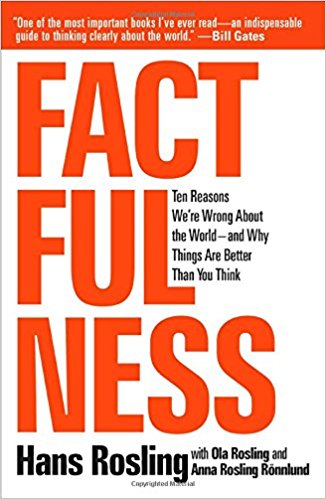You have /5 articles left.
Sign up for a free account or log in.
 Factfulness: Ten Reasons We're Wrong About the World--and Why Things Are Better Than You Think. By Hans Rosling
Factfulness: Ten Reasons We're Wrong About the World--and Why Things Are Better Than You Think. By Hans Rosling
Published in April of 2018.
The late Hans Rosling’s Factfulness is the third book on progress that I’ve read in 2018. The other two are Steven Pinker's Splendid Enlightenment Now (my review), and Gregg Easterbrook’s It's Better Than It Looks: Reasons for Optimism in an Age of Fear (my review).
Other books on progress that I’ve read and reviewed include: Progress: Ten Reasons to Look Forward to the Future by Johan Norberg (my review), The Great Surge: The Ascent of the Developing World by Steven Radelet (my review), and The Great Escape: Health, Wealth, and the Origins of Inequality by Angus Deaton (my review).
You might have also read Abundance: The Future Is Better Than You Think by Peter H. Diamandis and The Rational Optimist: How Prosperity Evolves by Matt Ridley.
These eight books, taken together, represent the modern canon of progress literature. I’m naming this thing. Prog Lit. Does that work?
If there is indeed a Prog Lit canon, then Factfulness is a worthy addition.
Factfulness shares many similarities with its cousins. Rosling cites a diverse set of data points to demonstrate how our world has transformed from one of near universal poverty, disease, illiteracy, and childhood mortality to a planet of middle-income consumers, whose children mostly survive.
Next time you are depressed, just think about how the proportion of the world’s population categorized as “extremely poor” has dropped from about 4-in-10 in 1981 to less than 1-in-10 today.
Anyone who has watched Rosling lecture (I still can’t believe he will lecture no more), knows about his questions and his bubble charts. He would ask an audience a question about infant mortality or female literacy or access to clean water. Most of the audience would then guess at the low-range for any economic, demographic, or health related variable for people living in what they assume is the developing world. Rosling would then show that the real numbers.
I’ll include some of Rosling’s questions at the bottom of this post. Please answer, if you wish, in the comments.
Where Rosling’s book differs from the other Prog Lit titles is along at least two dimensions.
First, Rosling does not try to offer many explanations for human material or health progress. He is chronicling how the world is changing, and how it will likely change in the future. (You may want to invest in Africa after reading Factfulness). What Rosling is not doing is delving into the economic, political, social, or institutional reasons underlying progress.
Second, Rosling really wants to help us think about the world more clearly. Factfulness is a self-help book for clear thinking. Among the recommendations that Rosling provides include being skeptical of easy answers or quick fixes, avoiding developing one’s world view from watching the news, and an insistence on following the data. Rosling is less interested in figuring out why we misconceive how the world works. Rather, he is content to help us see the world as it really is.
These are not shortcomings of Factfulness. The other books in on our Prog Lit reading list can help us understand the causes behind big changes, and the reasons why individuals and sometimes whole cultures (think academia) get things mostly wrong.
Okay, here is the quiz:
1. In all low-income countries across the world today, how many girls finish primary school?
A: 20 percent B: 40 percent C: 60 percent
2. Where does the majority of the world population live?
A: Low-income countries B: Middle-income countries C: High-income countries
3. In the last 20 years, the proportion of the world population living in extreme poverty has…
A: almost doubled B: remained more or less the same C: almost halved
4. What is the life expectancy of the world today?
A: 50 years B: 60 years C: 70 years
5. There are 2 billion children in the world today, aged 0 to 15 years old. How many children will there be in the year 2100, according to the United Nations?
A: 4 billion B: 3 billion C: 2 billion
6. The UN predicts that by 2100 the world population will have increased by another 4 billion people. What is the main reason?
A: There will be more children (age below 15) B: There will be more adults (age 15 to 74) C: There will be more very old people (age 75 and older)
7. How did the number of deaths per year from natural disasters change over the last hundred years?
A: More than doubled B: Remained about the same C: Decreased to less than half
8. How many of the world’s 1-year-old children today have been vaccinated against some disease?
A: 20 per cent B: 50 per cent C: 80 per cent
9. Worldwide, 30-year-old men have spent 10 years in school, on average. How many years have women of the same age spent in school?
A: 9 years B: 6 years C: 3 years
10. In 1996, tigers, giant pandas, and black rhinos were all listed as endangered. How many of these three species are more critically endangered today?
A: Two of them B: One of them C: None of them
11. How many people in the world have some access to electricity?
A: 20 per cent B: 50 per cent C: 80 per cent
12. Global climate experts believe that, over the next 100 years, the average temperature will…
A: get warmer B: remain the same C: get colder
Looking forward to seeing your quiz results. No cheating.
Can you point us to the mirror of the Prog Lit genre? The series of books on why the world is getting worse, and will be worse yet for our children and grandchildren?
What are you reading?




